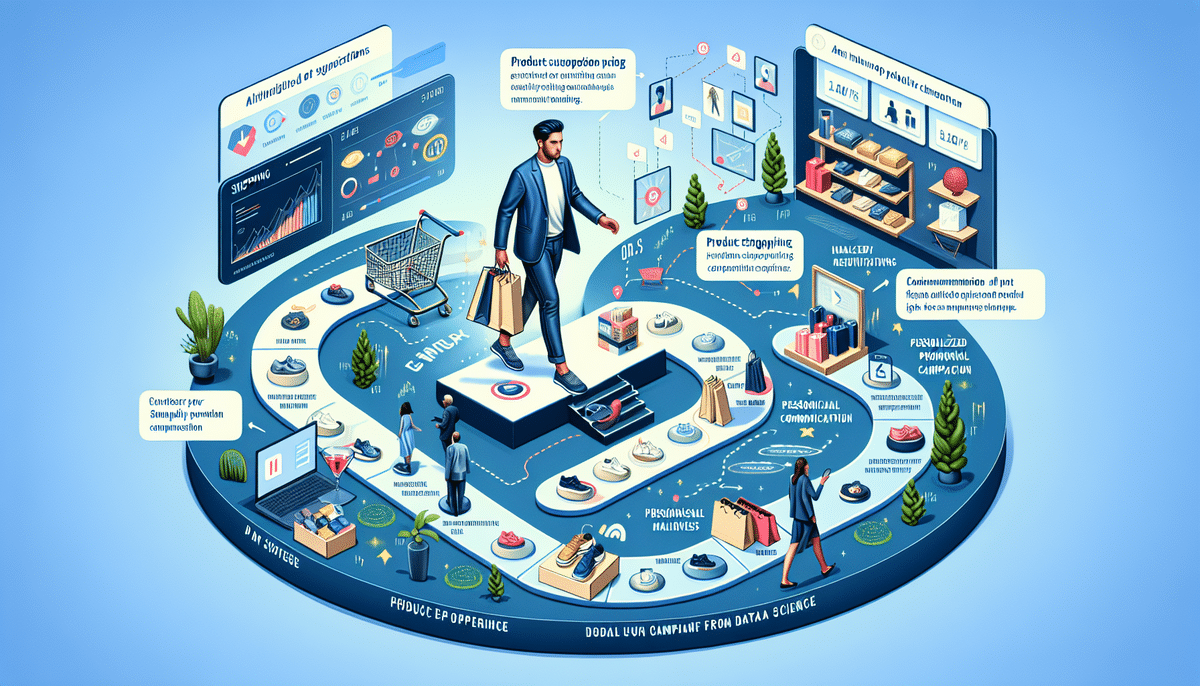Importance of Customer Experience in E-commerce
Customer experience (CX) has become a pivotal element in the success of e-commerce businesses. A positive CX not only fosters customer loyalty but also enhances brand reputation and drives sales growth. According to a 2023 study by Salesforce, 73% of customers consider CX a crucial factor in their purchasing decisions, with 64% willing to pay more for a superior experience. In a highly competitive digital marketplace, prioritizing CX is essential for e-commerce businesses to differentiate themselves and retain customers.
Personalization plays a significant role in enhancing CX. By tailoring the shopping experience to individual preferences and behaviors, businesses can increase customer satisfaction and loyalty. Techniques such as personalized product recommendations, targeted promotions, and customized content are effective strategies to achieve this personalization. Implementing these strategies can lead to higher conversion rates and increased revenue.
Common Challenges Faced by E-commerce Businesses
Technical Issues and Website Performance
E-commerce platforms often grapple with technical challenges, especially during peak traffic periods. Issues like site crashes, slow loading times, and payment gateway failures can significantly detract from the customer experience, leading to lost sales and diminished trust. Ensuring robust website infrastructure and scalable solutions is critical to maintaining seamless operations.
Inventory Management and Fulfillment
Efficient inventory management is another major hurdle. With the surge in online orders, tracking inventory levels and ensuring timely fulfillment becomes increasingly complex. Stockouts and delayed shipments can frustrate customers and harm the business’s reputation. Investing in advanced inventory management systems and reliable logistics partners is essential to mitigate these risks.
Increasing Competition in Digital Marketplaces
The proliferation of digital marketplaces has intensified competition among e-commerce businesses. Standing out in a crowded market requires innovative strategies and a deep understanding of customer needs. Differentiating through unique value propositions and exceptional customer service is key to gaining a competitive edge.
Understanding and Engaging Your Customers
Gathering and Analyzing Customer Data
To deliver exceptional CX, businesses must first understand their customers' needs and preferences. This involves collecting data through various channels such as customer feedback, surveys, and website analytics. Analyzing this data provides valuable insights that can inform strategic decisions to enhance the shopping experience.
Identifying Customer Pain Points
Recognizing and addressing customer pain points is crucial for improving CX. By analyzing complaints, feedback, and behavioral data, businesses can identify areas where customers encounter difficulties. Targeted improvements in these areas can lead to increased customer satisfaction and retention.
Recognizing Unique Preferences and Behaviors
Understanding the unique preferences and behaviors of customers allows businesses to tailor their offerings effectively. Factors such as preferred payment methods, shipping options, and product categories should be considered to create a personalized and enjoyable shopping experience.
Enhancing the Online Shopping Experience
Streamlining Navigation and Search Functionality
A streamlined shopping experience is fundamental to a positive CX. Ensuring that customers can effortlessly find what they are looking for is paramount. Implementing features like personalized search results, intuitive filters, and a well-designed navigation system can significantly enhance user experience.
Offering Multiple Payment Options
Providing a variety of payment methods, including credit/debit cards, PayPal, Apple Pay, and other digital wallets, caters to diverse customer preferences. This flexibility makes the checkout process more convenient and can reduce cart abandonment rates.
Detailed Product Information and Reviews
Offering comprehensive product information, high-quality images, videos, and customer reviews helps customers make informed purchasing decisions. Transparent and detailed descriptions can reduce the likelihood of returns and negative reviews, thereby improving overall customer satisfaction.
Optimizing the Checkout Process
The checkout process is a critical touchpoint in the customer journey. Simplifying this process by reducing the number of steps, offering guest checkout options, and ensuring mobile-friendliness can enhance the shopping experience. Additionally, providing order confirmation and tracking information builds trust and keeps customers informed.
Building Trust and Transparency with Customers
Clear and Concise Communication
Transparency in pricing, policies, and product information is essential for building trust. Providing clear and concise descriptions, easily accessible customer service channels, and transparent shipping and return policies can reassure customers and foster loyalty.
Effective Communication Strategies
Maintaining open and honest communication with customers is vital. Promptly addressing inquiries and concerns, providing regular updates on order status, and being upfront about any issues or delays contribute to a trustworthy relationship. Effective communication can lead to repeat business and positive word-of-mouth referrals.
Leveraging Technology to Improve Customer Experience
Artificial Intelligence and Chatbots
AI-powered chatbots can enhance CX by providing instant support and personalized recommendations. These tools can handle a wide range of customer interactions, from answering common questions to guiding users through the purchasing process, thereby improving efficiency and satisfaction.
Virtual Reality (VR) Enhancements
Virtual Reality offers immersive shopping experiences, allowing customers to visualize products in their environment before making a purchase. This technology is particularly beneficial for industries like fashion and home decor, where visual representation plays a crucial role in decision-making.
Data Analytics for Personalization
Data analytics enables businesses to personalize the shopping experience by analyzing customer behavior, purchase history, and search queries. Insights derived from data can drive targeted marketing campaigns, customized offers, and product recommendations that resonate with individual customers.
For example, businesses can address cart abandonment by implementing strategies based on data-driven insights. According to a Shopify report, personalized follow-up emails can recover up to 30% of abandoned carts.
Measuring and Evaluating Customer Experience Strategy
Key Metrics for Success
Tracking and evaluating CX strategies is essential for continuous improvement. Key metrics include customer satisfaction scores, Net Promoter Score (NPS), conversion rates, and website traffic. These indicators help businesses understand the effectiveness of their CX initiatives and identify areas for enhancement.
Customer Retention Rates
Customer retention rate measures the percentage of customers who make repeat purchases. A high retention rate signifies strong customer loyalty and satisfaction. Strategies to improve retention include exceptional customer service, personalized experiences, and loyalty programs.
Data-Driven Decision Making
Utilizing data to inform decision-making ensures that CX strategies are aligned with customer needs and market trends. Analyzing patterns in customer behavior and feedback allows businesses to make informed adjustments that enhance the overall shopping experience.
Handling Returns and Refunds: Best Practices for Positive Customer Experience
Clear Return Policies
Having transparent and accessible return policies is crucial for minimizing customer frustration. Clear guidelines on return procedures, eligibility, and timelines help set customer expectations and reduce uncertainties.
Streamlined Return Process
Implementing a straightforward return process enhances customer satisfaction. Offering options such as free return shipping, store credit, or exchanges provides flexibility and convenience, encouraging customers to shop again.
Analyzing Return Reasons
Tracking and analyzing the reasons behind returns can provide valuable insights into product quality and customer preferences. Addressing recurring issues can lead to product improvements and a decrease in return rates, thereby enhancing overall customer satisfaction.
Case Studies: Examples of Successful E-commerce Businesses that Improved Customer Experience
Amazon: Personalized Recommendations and One-Click Checkout
Amazon has set industry standards with its personalized recommendation engine and one-click checkout feature. These innovations simplify the shopping process, making it easier for customers to find and purchase products, thereby increasing sales and customer loyalty.
Zappos: Exceptional Customer Service
Zappos is renowned for its customer-centric approach, offering exceptional customer service that goes above and beyond expectations. Their commitment to customer satisfaction has built a strong, loyal customer base and solidified their reputation in the e-commerce space.
Studying these examples provides valuable insights for businesses looking to enhance their own CX strategies. By adopting similar approaches, e-commerce companies can achieve significant improvements in customer satisfaction and business performance.
Conclusion: Key Takeaways for Improving Your E-commerce Customer Experience
In the competitive landscape of e-commerce, delivering a superior customer experience is essential for success. By prioritizing customer needs, leveraging advanced technologies, and continuously measuring and optimizing CX strategies, businesses can overcome challenges and create engaging, memorable shopping experiences. Building trust through transparency, personalizing interactions, and streamlining the online shopping process are key components in achieving outstanding customer satisfaction and fostering long-term loyalty.






















